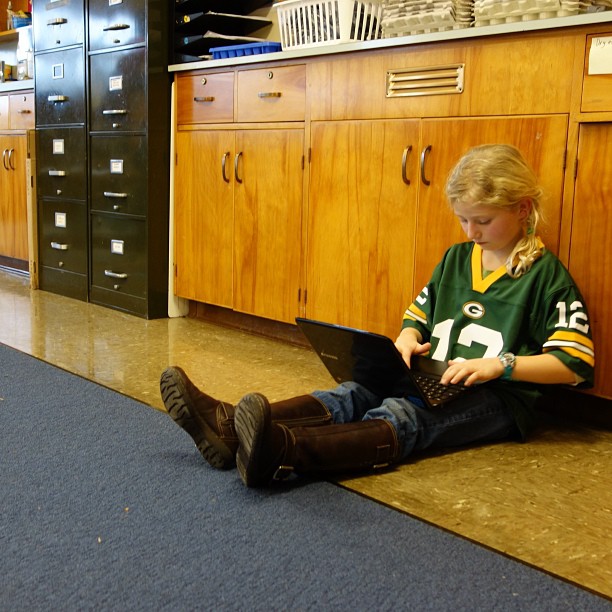
As More Oklahoma Schools Give Students Computers, Experts Say Teacher Training Is Key
-
Emily Wendler
This year, two of Oklahoma’s largest school districts are embarking on an expensive technological experiment: They’re giving students their own laptops to use in class — and take home.
Rich Anderson is in charge of making sure Edmond Public School’s laptop program rolls out smoothly.
“In my mind, I’m calling it ‘C-day’,” he says.
That’s “C-Day” for Chromebook Day. The day when every 8th, 9th, and 10th grader gets their own. The Chromebooks are small laptops that will become a part of each student’s daily learning experience. They’ll use them in class, for research, and at home for homework. Anderson tells parents that, eventually, these computers will replace textbooks.
In total, the district will distribute about 5,500 Chromebooks to students in Edmond this year. Anderson says the move is an attempt to ready kids for the future.
“Our goal is to prepare students to succeed in life, in college and in the job market,” he says. “Being confident with technology is part of that.”
Norman Public Schools is doing something similar this year, too: The district is giving its middle and high school students MacBooks. Other districts in Oklahoma, including schools in Jenks and Enid, have been giving kids computers for a couple years.
These programs cost millions. Some are funded by grants, but usually the programs are financed by bond money. Anderson thinks it’s money well spent.
“It’s a transformation of the way teachers teach,” he said. “It’s about a new way of learning that’s more student driven, more collaborative.”
Research shows giving kids their own computer can definitely be worth it. When done the right way, laptop programs have proven to increase learning in writing, math, and science.
But experts say the way public schools carry out these take-home-tech programs is key, and without the proper preparation they can be a waste of time and money.
Making It Work
Schools across the country have botched the rollout of their tech-device programs.
The most notorious isthe Los Angeles Unified District’s experience. The country’s largest school district spent $1.3 billion on iPads and online curriculum, but after two years of technical difficulties, district officials told Apple they wanted their money back.
The Fort Bend Independent School District in Texasscrapped a $16 million iPad program after just a year. The district purchased 6,300 iPads with the hope of improving science scores, but instead experienced problem after problem. An independent review of the program found the district’s timetable for rolling it out was too fast, the online curriculum didn’t match the state’s standards, and the district failed to hire people with the right skills to manage the plan.
Maine, on the other hand, started the first statewide laptop program 15 years ago — and it’s still running. Bernadette Doykos works for the Maine Education Policy Research Institute, and studies the state’s program.
She says districts can’t simply put laptops in classroom and expect things to change. First, schools have to train their teachers to use the technology.
“I really cannot stress enough how much teacher prep plays into this,” she says.
Doykos says teachers need help navigating the enormous selection of online curriculum that’s available, because some of it’s good and some of it’s bad. With the right software, Doykos says educators can personalize learning, and communicate better with parents.
“That is so exciting,” she says. “And when it’s done, it really has such a powerful impact on kids, but it takes a lot of preparation to be able to do that.”
Positive Potential
Anderson, Edmond’s director of technology, understands it’s a delicate process.
His district is rolling out its laptop program slowly, targeting a few grades each year. Edmond schools also held lots of training sessions for teachers over the summer, and piloted the program in a few classrooms last year.
Eighth grade science teacher Cara Stephens was part of the first trial runs, and said she saw a lot of potential.
“It just opens up so many doors for them,” she says.
Stephens says her students’ tech skills are surprisingly lacking, but she thinks the laptops will help them improve.
“People think eighth graders know how to use technology, and they don’t,” she says. “They know how to text, they know how to Snapchat. They don’t know how to turn on a Chromebook. They don’t know create a Word document.”
The laptops also expand learning opportunities beyond what’s possible with textbooks or traditional classroom labs, Stephens says.
“There’s actually a lab where they can drop different objects on different planets, and then we talk about the gravity on different planets,” she says. “They can’t just do that on paper. They can’t drop a piano on Jupiter.”
Stephens thinks there will be a new learning curve this year, because now kids are actually taking the Chromebooks home, where as last year the computers stayed in the classroom.
And, while the idea of trusting students with laptops sounds like a pricey gamble, Stephens says that’s one part of the tech program she’s not too worried about.
“Until it happens, I don’t know what to anticipate,” she said. “They don’t have a problem holding onto their cell phones.”
Overall, she’s optimistic.
“If you expect things consistently from your students, they tend to meet your expectations,” she says.
